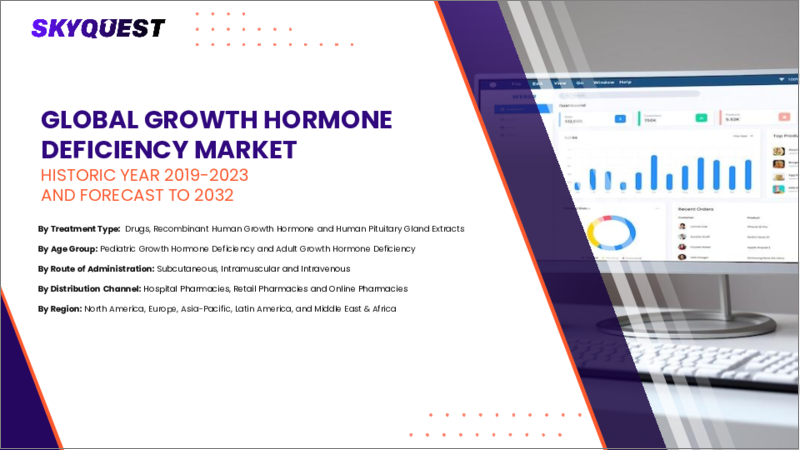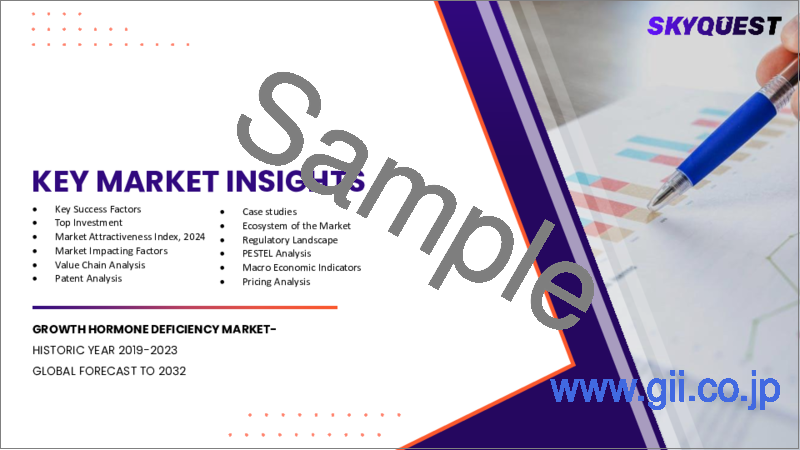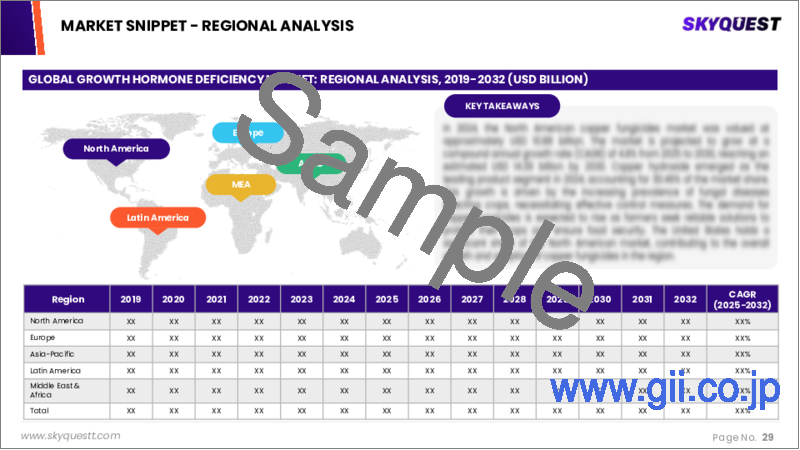|
|
市場調査レポート
商品コード
1701016
成長ホルモン欠乏症の市場規模、シェア、成長分析:タイプ別、診断別、治療別、投与経路別、エンドユーザー別、地域別 - 産業予測 2025~2032年Growth Hormone Deficiency Market Size, Share, and Growth Analysis, By Type, By Diagnosis, By Treatment, By Route of Administration, By End User, By Region - Industry Forecast 2025-2032 |
||||||
|
|||||||
| 成長ホルモン欠乏症の市場規模、シェア、成長分析:タイプ別、診断別、治療別、投与経路別、エンドユーザー別、地域別 - 産業予測 2025~2032年 |
|
出版日: 2025年04月02日
発行: SkyQuest
ページ情報: 英文 219 Pages
納期: 3~5営業日
|
全表示
- 概要
- 目次
成長ホルモン欠乏症市場規模は2023年に37億米ドルと評価され、2024年の39億米ドルから2032年には59億9,000万米ドルに成長し、予測期間(2025~2032年)のCAGRは5.5%で成長する見通しです。
遺伝子疾患、脳損傷、特定の治療などの要因によって成長ホルモン欠乏症(GHD)の発症率が上昇していることが、成長ホルモン治療の需要を大幅に押し上げています。米国国立生物工学情報センター(NCBI)のデータによると、英国では約3,500~4,000人に1人が小児GHDに罹患しており、効果的な治療に対するニーズが高まっています。このような有病率の増加は、業界の拡大に拍車をかけており、その最前線には強力な研究開発があります。2022年2月、ファイザーとOPKOが週1回投与のNGENLA(TM)(somatrogon)注射剤の欧州連合(EU)販売承認を取得したことは、成長ホルモン治療の展望における重要なマイルストーンであり、業界の成長軌道をさらに強固なものにしました。
目次
イントロダクション
- 調査の目的
- 調査範囲
- 定義
調査手法
- 情報調達
- 二次と一次データの方法
- 市場規模予測
- 市場の前提条件と制限
エグゼクティブサマリー
- 世界市場の見通し
- 供給と需要の動向分析
- セグメント別機会分析
市場力学と見通し
- 市場概要
- 市場規模
- 市場力学
- 促進要因と機会
- 抑制要因と課題
- ポーターの分析
主な市場の考察
- 重要成功要因
- 競合の程度
- 主な投資機会
- 市場エコシステム
- 市場の魅力指数(2024年)
- PESTEL分析
- マクロ経済指標
- バリューチェーン分析
- 価格分析
- 規制分析
成長ホルモン欠乏症市場規模:タイプ別
- 市場概要
- 小児成長ホルモン欠乏症
- 成人成長ホルモン欠乏症
成長ホルモン欠乏症市場規模:診断別
- 市場概要
- 血液検査
- 画像検査
- コンピュータ断層撮影(CT)スキャン
- 磁気共鳴画像法(MRI)
- その他
成長ホルモン欠乏症市場規模:治療別
- 市場概要
- 薬物療法
- 組み換えヒト成長ホルモン
- ヒト下垂体抽出物
- 手術
成長ホルモン欠乏症市場規模:投与経路別
- 市場概要
- 静脈内
- 筋肉内
- その他
成長ホルモン欠乏症市場規模:エンドユーザー別
- 市場概要
- 病院
- ホームケア
- 専門クリニック
- その他
成長ホルモン欠乏症市場規模:流通チャネル別
- 市場概要
- 病院薬局
- オンライン薬局
- 小売薬局
成長ホルモン欠乏症市場規模
- 北米
- 米国
- カナダ
- 欧州
- ドイツ
- スペイン
- フランス
- 英国
- イタリア
- その他欧州地域
- アジア太平洋地域
- 中国
- インド
- 日本
- 韓国
- その他アジア太平洋地域
- ラテンアメリカ
- ブラジル
- その他ラテンアメリカ地域
- 中東・アフリカ
- GCC諸国
- 南アフリカ
- その他中東・アフリカ
競合情報
- 上位5社の比較
- 主要企業の市場ポジショニング(2024年)
- 主な市場企業が採用した戦略
- 最近の市場動向
- 企業の市場シェア分析(2024年)
- 主要企業の企業プロファイル
- 企業の詳細
- 製品ポートフォリオ分析
- 企業のセグメント別シェア分析
- 収益の前年比比較(2022~2024年)
主要企業プロファイル
- Pfizer Inc.(USA)
- Eli Lilly and Company(USA)
- Novo Nordisk A/S(Denmark)
- Ipsen S.A.(France)
- Ascendis Pharma A/S(Denmark)
- Ferring Pharmaceuticals(Switzerland)
- OPKO Health Inc.(USA)
- Genexine, Inc.(South Korea)
- LG Chem Ltd.(South Korea)
- Anhui Anke Biotechnology(China)
- Teva Pharmaceutical Industries Ltd.(Israel)
- JCR Pharmaceuticals Co., Ltd.(Japan)
- Shanghai United Cell Biotechnology Co., Ltd.(China)
- Hanmi Pharmaceutical Co., Ltd.(South Korea)
- Strongbridge Biopharma plc(USA)
- GeneScience Pharmaceuticals Co., Ltd.(China)
- Cipla Limited(India)
- BIOCAD(Russia)
- Krka, d. d.(Slovenia)
- OPBIO Factory Co., Ltd.(South Korea)
結論と提言
Growth Hormone Deficiency Market size was valued at USD 3.7 billion in 2023 and is poised to grow from USD 3.9 billion in 2024 to USD 5.99 billion by 2032, growing at a CAGR of 5.5% during the forecast period (2025-2032).
The rising incidence of growth hormone deficiency (GHD), driven by factors like genetic disorders, brain injuries, and specific medical treatments, is significantly boosting the demand for growth hormone therapies. Data from the National Center for Biotechnology Information (NCBI) indicates that approximately 1 in every 3,500-4,000 children in the UK is affected by pediatric GHD, highlighting a growing need for effective treatments. This increasing prevalence is catalyzing industry expansion, with robust research and development at the forefront. A notable advancement occurred in February 2022 when Pfizer and OPKO received European Union marketing authorization for their Once-Weekly NGENLA(TM) (somatrogon) Injection, marking an important milestone in the growth hormone therapy landscape and further cementing the industry's growth trajectory.
Top-down and bottom-up approaches were used to estimate and validate the size of the Growth Hormone Deficiency market and to estimate the size of various other dependent submarkets. The research methodology used to estimate the market size includes the following details: The key players in the market were identified through secondary research, and their market shares in the respective regions were determined through primary and secondary research. This entire procedure includes the study of the annual and financial reports of the top market players and extensive interviews for key insights from industry leaders such as CEOs, VPs, directors, and marketing executives. All percentage shares split, and breakdowns were determined using secondary sources and verified through Primary sources. All possible parameters that affect the markets covered in this research study have been accounted for, viewed in extensive detail, verified through primary research, and analyzed to get the final quantitative and qualitative data.
Growth Hormone Deficiency Market Segments Analysis
Global Growth Hormone Deficiency Market is segmented by Type, Diagnosis, Treatment, Route of Administration, End User, Distribution Channel and region. Based on Type, the market is segmented into Pediatric Growth Hormone Deficiency and Adult Growth Hormone Deficiency. Based on Diagnosis, the market is segmented into Blood Tests, Imaging Tests, Computerized tomography (CT) scans, Magnetic resonance imaging (MRI) and Others. Based on Treatment, the market is segmented into Pharmacological Therapy, Recombinant Human Growth Hormone, Human Pituitary Gland Extracts, and Surgery. Based on Route of Administration, the market is segmented into Intravenous, Intramuscular and Others. Based on End User, the market is segmented into Hospitals, Homecare, Specialty Clinics and Others. Based on Distribution Channel, the market is segmented into Hospital Pharmacy, Online Pharmacy and Retail Pharmacy. Based on region, the market is segmented into North America, Europe, Asia Pacific, Latin America and Middle East & Africa.
Driver of the Growth Hormone Deficiency Market
One of the key market drivers for the global growth hormone deficiency market is the increasing prevalence of growth hormone deficiency and related disorders among children and adults. This rise is partly attributed to better diagnosis and awareness, leading to earlier identification and treatment. Additionally, lifestyle factors, such as sedentary habits and rising obesity rates, contribute to hormonal imbalances, further fueling the need for growth hormone therapies. As healthcare providers continue to emphasize the importance of addressing growth issues and improving quality of life, the demand for effective growth hormone treatments is expected to grow significantly in the coming years.
Restraints in the Growth Hormone Deficiency Market
The market for Growth Hormone Deficiency faces significant restraints, primarily due to the high costs associated with Human Growth Hormone (HGH) therapy. This financial burden limits accessibility for various patient groups and places considerable strain on healthcare systems. A 2022 medical journal study highlighted the extensive financial challenges faced by patients and healthcare providers alike, emphasizing the need for more affordable treatment options. Addressing these economic hurdles is crucial for enhancing access to HGH therapy, prompting calls for the development of cost-effective solutions and pricing reforms to ensure that more individuals can benefit from necessary treatments without extreme financial hardship.
Market Trends of the Growth Hormone Deficiency Market
The Growth Hormone Deficiency (GHD) market is experiencing a noteworthy shift driven by innovative advancements in drug delivery systems. The introduction of wearable patches, needle-free devices, and autoinjectors enhances patient convenience and compliance, transforming how growth hormone therapies are administered. Additionally, the rise of long-acting formulations and implantable devices allows for extended-release options, significantly reducing the frequency of dosing. These innovations not only improve treatment efficacy but also elevate patient experiences, enabling wider accessibility to essential therapies. As the industry embraces these developments, the GHD market is set for robust growth, highlighting significant opportunities for pharmaceutical companies and healthcare providers alike.
Table of Contents
Introduction
- Objectives of the Study
- Scope of the Report
- Definitions
Research Methodology
- Information Procurement
- Secondary & Primary Data Methods
- Market Size Estimation
- Market Assumptions & Limitations
Executive Summary
- Global Market Outlook
- Supply & Demand Trend Analysis
- Segmental Opportunity Analysis
Market Dynamics & Outlook
- Market Overview
- Market Size
- Market Dynamics
- Drivers & Opportunities
- Restraints & Challenges
- Porters Analysis
- Competitive rivalry
- Threat of substitute
- Bargaining power of buyers
- Threat of new entrants
- Bargaining power of suppliers
Key Market Insights
- Key Success Factors
- Degree of Competition
- Top Investment Pockets
- Market Ecosystem
- Market Attractiveness Index, 2024
- PESTEL Analysis
- Macro-Economic Indicators
- Value Chain Analysis
- Pricing Analysis
- Regulatory Analysis
Global Growth Hormone Deficiency Market Size by Type & CAGR (2025-2032)
- Market Overview
- Pediatric Growth Hormone Deficiency
- Adult Growth Hormone Deficiency
Global Growth Hormone Deficiency Market Size by Diagnosis & CAGR (2025-2032)
- Market Overview
- Blood Tests
- Imaging Tests
- Computerized tomography (CT) scans
- Magnetic resonance imaging (MRI)
- Others
Global Growth Hormone Deficiency Market Size by Treatment & CAGR (2025-2032)
- Market Overview
- Pharmacological Therapy
- Recombinant Human Growth Hormone
- Human Pituitary Gland Extracts
- Surgery
Global Growth Hormone Deficiency Market Size by Route of Administration & CAGR (2025-2032)
- Market Overview
- Intravenous
- Intramuscular
- Others
Global Growth Hormone Deficiency Market Size by End User & CAGR (2025-2032)
- Market Overview
- Hospitals
- Homecare
- Specialty Clinics
- Others
Global Growth Hormone Deficiency Market Size by Distribution Channel & CAGR (2025-2032)
- Market Overview
- Hospital Pharmacy
- Online Pharmacy
- Retail Pharmacy
Global Growth Hormone Deficiency Market Size & CAGR (2025-2032)
- North America (Type, Diagnosis, Treatment, Route of Administration, End User, Distribution Channel)
- US
- Canada
- Europe (Type, Diagnosis, Treatment, Route of Administration, End User, Distribution Channel)
- Germany
- Spain
- France
- UK
- Italy
- Rest of Europe
- Asia Pacific (Type, Diagnosis, Treatment, Route of Administration, End User, Distribution Channel)
- China
- India
- Japan
- South Korea
- Rest of Asia-Pacific
- Latin America (Type, Diagnosis, Treatment, Route of Administration, End User, Distribution Channel)
- Brazil
- Rest of Latin America
- Middle East & Africa (Type, Diagnosis, Treatment, Route of Administration, End User, Distribution Channel)
- GCC Countries
- South Africa
- Rest of Middle East & Africa
Competitive Intelligence
- Top 5 Player Comparison
- Market Positioning of Key Players, 2024
- Strategies Adopted by Key Market Players
- Recent Developments in the Market
- Company Market Share Analysis, 2024
- Company Profiles of All Key Players
- Company Details
- Product Portfolio Analysis
- Company's Segmental Share Analysis
- Revenue Y-O-Y Comparison (2022-2024)
Key Company Profiles
- Pfizer Inc. (USA)
- Company Overview
- Business Segment Overview
- Financial Updates
- Key Developments
- Eli Lilly and Company (USA)
- Company Overview
- Business Segment Overview
- Financial Updates
- Key Developments
- Novo Nordisk A/S (Denmark)
- Company Overview
- Business Segment Overview
- Financial Updates
- Key Developments
- Ipsen S.A. (France)
- Company Overview
- Business Segment Overview
- Financial Updates
- Key Developments
- Ascendis Pharma A/S (Denmark)
- Company Overview
- Business Segment Overview
- Financial Updates
- Key Developments
- Ferring Pharmaceuticals (Switzerland)
- Company Overview
- Business Segment Overview
- Financial Updates
- Key Developments
- OPKO Health Inc. (USA)
- Company Overview
- Business Segment Overview
- Financial Updates
- Key Developments
- Genexine, Inc. (South Korea)
- Company Overview
- Business Segment Overview
- Financial Updates
- Key Developments
- LG Chem Ltd. (South Korea)
- Company Overview
- Business Segment Overview
- Financial Updates
- Key Developments
- Anhui Anke Biotechnology (China)
- Company Overview
- Business Segment Overview
- Financial Updates
- Key Developments
- Teva Pharmaceutical Industries Ltd. (Israel)
- Company Overview
- Business Segment Overview
- Financial Updates
- Key Developments
- JCR Pharmaceuticals Co., Ltd. (Japan)
- Company Overview
- Business Segment Overview
- Financial Updates
- Key Developments
- Shanghai United Cell Biotechnology Co., Ltd. (China)
- Company Overview
- Business Segment Overview
- Financial Updates
- Key Developments
- Hanmi Pharmaceutical Co., Ltd. (South Korea)
- Company Overview
- Business Segment Overview
- Financial Updates
- Key Developments
- Strongbridge Biopharma plc (USA)
- Company Overview
- Business Segment Overview
- Financial Updates
- Key Developments
- GeneScience Pharmaceuticals Co., Ltd. (China)
- Company Overview
- Business Segment Overview
- Financial Updates
- Key Developments
- Cipla Limited (India)
- Company Overview
- Business Segment Overview
- Financial Updates
- Key Developments
- BIOCAD (Russia)
- Company Overview
- Business Segment Overview
- Financial Updates
- Key Developments
- Krka, d. d. (Slovenia)
- Company Overview
- Business Segment Overview
- Financial Updates
- Key Developments
- OPBIO Factory Co., Ltd. (South Korea)
- Company Overview
- Business Segment Overview
- Financial Updates
- Key Developments






